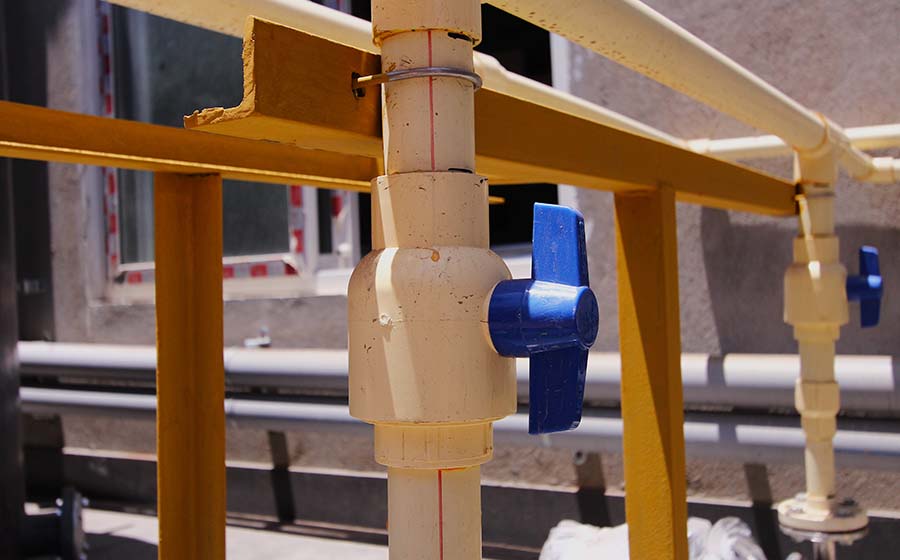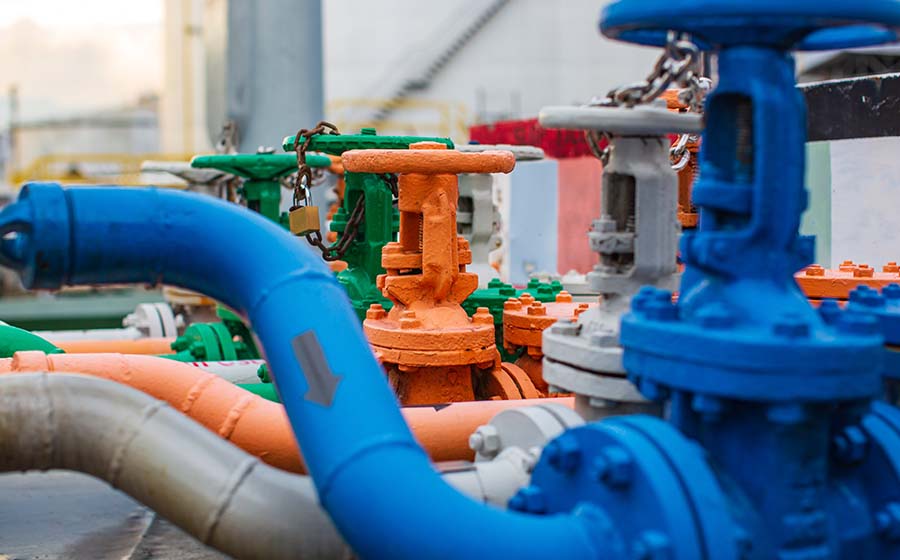
Types of Valves Used in Piping Systems and Their Classifications
Industries run on a number of machines, and each machine has a thousand different parts to it. Valves are an important part of these machines – they control the flow of liquids and gases in piping systems. It’s important to learn the different types of industrial valves used in piping systems, and their classification, so that you can use the right one for your setup.
What Is a Valve? Why Is It Important?

A valve is a mechanical device used in fluid systems to adjust the pipe’s route and regulate, steer, segregate, blend, or control the flow or pressure of a fluid. When a valve is open, the pathway is clear and the fluid moves from a higher pressure to a lower pressure environment. The flow can be decreased or halted entirely by completely or partially blocking the valve’s path.
Although technically a pipe fitting, valves are typically thought of independently from other fittings due to their important role, large variety of varieties, and operational possibilities. Different types of valves are used in the piping system, each with its own functionality. The cost of industrial valves can account for up to 30% of the total cost of the piping system in a plant, making them frequently the most expensive parts of the piping system.
The Role of Industrial Valves in Piping Systems

Valves are essential for boosting a process’s efficiency, enhancing quality control, and assuring its constancy. The required function of the industrial valve is the main factor to be taken into account when choosing a valve. Valves are primarily used for isolation, regulation, and control.
- Changing the direction of fluid flow
- Reducing the flow rates through a pipe system
- Temperature control of fluids in a piping system
- Control of pressure
- Limiting the flow to maintain system balance or avoid over-pressurization
- Prevent liquids from flowing backwards
- Halting the flow in the event of a system malfunction
- Reducing pressure or vacuum in a pipe system to increase safety
- Switching up the direction of the flow
When designing a manufacturing process or piping system, engineers generally specify the type of valve needed for the desired function on the Process and Instrumentation Diagram (P&ID). Depending on the application, they can be classified according to their use, their operating principle, their structure, or their method of installation.
Different Types of Valves in Piping Systems
Gate Valves

The most prevalent kind of industrial valves seen in process facilities are Gate Valves. A linear path is followed by the closing gate to either obstruct or let fluid passage. Gate valves are thought to be suited for practically all fluid services, including air, fuel gas, feed-water, steam, slurries, and viscous liquids, and they offer good cutoff.
- Gate valves are economical and easy to service. They have low fluid resistance because fluid can flow straight through without changing direction.
- Gate valves are not advised for flow control because the flow is difficult to control due to the valve design. They are normally kept in either a fully open or fully closed position when in use.
- Fluid slapping against a partially open gate can damage valves. These valves are not good for applications that need quick functioning.
Globe Valve

A Globe Valve typically has a spherical body with a stationary ring seat and a moving plug element, separated by an internal baffle. The plug element is attached to an operational hand wheel by a stem, and is moved toward or away from the ring seat by the screw action as the wheel is rotated.
- Globe valves are used to control fluid flow by regulating the space between the plug element and ring seat. They are often used in systems where leak tightness is crucial, like cooling water systems and fuel/lubricating oil systems.
- Globe valves are more expensive than gate valves but offer better throttling and shut off control. Their intricate designs cause the fluid to reverse its flow, resulting in significant pressure loss and turbulence.
- Globe valves usually weigh more than other valves, and they aren't good for fluids that contain particles, highly viscous fluids, or other choking-prone mediums.
Did you know that there are other types of industrial valves too? Check out the EuroIndustriel page to browse through our selection of Industrial Valves.
Ball Valve

A hollow ball is used by a ball valve to control fluid flow. The ball has a hole in it, and when the hole is lined up with the entrance to the flow, the fluid can go through. The ball is rotated by 90° to block the flow when the valve handle is rotated by a quarter turn.
- Ball valves are more compact, lighter, and less expensive than gate valves. They enable visual detection of the valve's open or closed condition and provide simple operation, large volume flow, high pressure, and extended service lives.
- Ball valves can also be repaired without removing the valve body from the line.
- Ball valves are hard to clean and this could lead to contamination. They are not good for applications that need to constantly control the throttle.
Check Valve/Non-return Valve

Check valves are used in piping systems to prevent backflow. The valve opens when fluid pressure moves through the pipeline, and shuts when reverse flow occurs. This is a very important part of the different types of valves used in piping systems across industries.
- Check valves don't need to be managed externally and have a one-way flap mechanism.
- Check valves are small and affordable. They are used in different industrial settings, such as gas mixing systems and fuel and oxidizer mixing systems.
- Check valves are also used in household applications to prevent the mixing of a sanitary potable water supply with water.
Plug Valve

Plug valves use a cylindrical or conical plug to restrict or allow fluid flow. The plug has one or more hollow tunnels that allow fluid to pass through when aligned with the flow direction. The plug must be turned with a quarter-turn rotating action to stop fluid flow. Plug valves work well in applications where slurry might blockage. The plug’s wiping motion prevents suspended particles from accumulating.
- Plug valves are useful in many situations, such as when handling gases and vapors, in oil piping systems, or in sewage, natural gas, coal, and mineral applications. They can also be used in high-pressure and vacuum applications.
- Plug valves offer a long service life and good reliability, making them suitable for corrosive, abrasive, and poisonous materials. They are employed as on-off stop valves to offer an immediate bubble-tight shutoff. The valves can be maintained and cleaned without removing the body from the piping system.
- Plug valves aren't recommended for applications that need high frequency switching or throttling because they are more expensive and need more force to operate as compared to ball valves.
Butterfly Valve

The term “butterfly” designates a rotating metal disc that is fixed to a rod. The valve can only be opened or closed with a quarter turn of the disc. The disk entirely closes up the passageway when it is in the closed position. When the disc is open, its face is parallel to the flow direction and virtually unlimited fluid flow is possible.
- Butterfly valves are used in high-pressure, high-temperature steam and water systems as well as cooling water systems, compressed air or gas applications, fire protection, slurry services, and vacuum services.
- Because of their short, round bodies, butterfly valves require less room, are lighter, and are simpler to install. They are excellent for big valve applications due to their compact construction. The coefficient of flow is high for butterfly valves. Even under low pressure, they provide good sealing.
- The throttling function of butterfly valves, on the other hand, is restricted to low differential pressure, and unguided disc movement can be impacted by flow turbulence. They can also be challenging to clean.
Needle Valve

Globe and needle valves have a similar design. These valves use a long, tapered plunger that resembles a needle to seal the valve and stop the flow of fluid. The flow route is opened or closed by turning a stem to insert or retract the plunger. The plunger must be fully retracted after a number of spins on the finely threaded stem, which enables accurate flow rate management. In small diameter piping systems, needle valves are frequently utilized to achieve the most precise flow control possible.
In general, systems with low viscosity fluids moving at modest flow rates are suited for needle valves. The most typical usage is to control flow to delicate gauges to guard against damage from a rapid pressure rise. They can also be used as bleed valves to release pressure or drain fluid for maintenance or analysis.
Pinch Valve

With pinch valves, the flow through the elastic tubing is directly restricted by a pinching device. To make a seal, the pinching mechanism flattens the tube. Fluid flow can be started, stopped, and controlled using pinch valves.
- These valves are less expensive and more leak-proof than other valves since they have fewer parts. These valves are perfect for handling slurries and pneumatic transmission of solid solids.
- Pinch valves reduce flow turbulence and friction.
- However, they are not appropriate for applications involving gases or high temperatures or pressures.
Diaphragm Valve

A diaphragm valve has a thin, flexible diaphragm that rests on a seat when the valve is closed. A linear compressor is used to force the diaphragm against the seat, closing the valve.
- Diaphragm valves can be used for throttling applications and work well with viscous fluids or fluids containing solid components.
- Diaphragm valves are reliable and efficient. The diaphragm material affects the functioning temperature and pressure of diaphragm valves. The diaphragm can eventually wear out, causing valve failure.
Conclusion
There is a wide variety of valves used in piping systems, each with their own unique set of benefits and drawbacks. The type of valve you need will depend on the specific application and what functionality is required.
Euroindustriel are industry leaders in industrial valve designing and production, and can help you select the perfect valve for your needs. Our te















